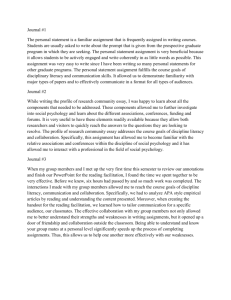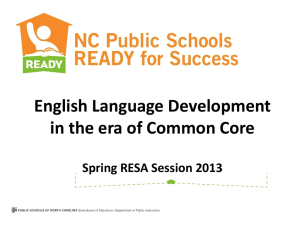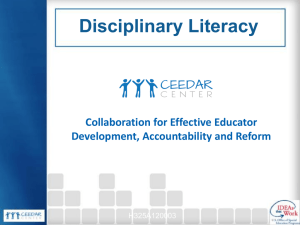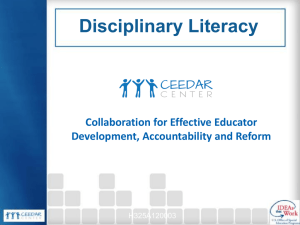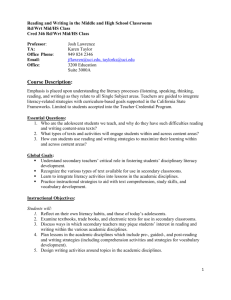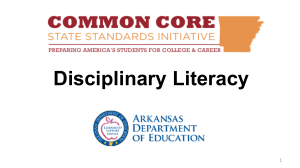Disciplinary Literacy
advertisement
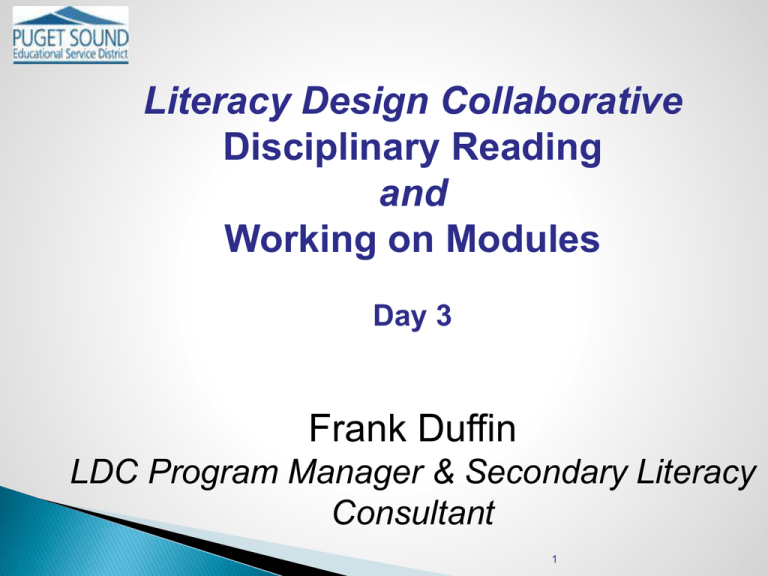
Literacy Design Collaborative Disciplinary Reading and Working on Modules Day 3 Frank Duffin LDC Program Manager & Secondary Literacy Consultant 1 Goals of the LDC Workshop Share lessons learned from Days 1 and 2 trainings and task implementation specific to each discipline. Scaffold literacy skills to advance achievement in the discipline area. Fully develop a Module using Task 2 for jurying. 2 1. What are you pondering? 2. What is working so far? 3. What questions do you have? 4. What help do you need? 3 Content reading area Disciplinary literacy How do you develop tasks that engage and apprentice students in reading and responding to challenging texts in your discipline? 5 Disciplinary literacy is the approach that the common core has taken. Let’s… ◦ explore dimensions of disciplinary literacy ◦ distinguish between content area reading and disciplinary literacy 6 Content Area Reading Disciplinary Literacy Source Reading experts since 1920s Wider range of experts since 1990s Nature of skills Generalizable Specialized Focus Use of reading and writing to study/learn information How literacy is used to make meaning within a discipline Students Remedial Whole distribution Texts Often encourages use of literary text Only focuses on disciplinary text Role of graphics Ignored or taught generally Specific to the discipline Disciplinary Literacy Skill specialized to history, science, literature, math, Intermediate and Career and Literacy Technical Education Generic comprehension strategies, common word meanings, & basic fluency Basic Literacy Decoding and knowledge of high frequency words. Technical, abstract, dense, tightly knit language (that contrasts with interactive, interpersonal style of other texts or ordinary language) Nominalization (turning processes into nouns) Suppresses agency (readers need to focus on causation not intention) Sentence density: unpacking complex nouns Experimental verification of Einstein’s explanation of the photoelectric effect was made 11 years later by the American physicist Robert Millikan. Every aspect of Einstein’s interpretation was confirmed, including the direct proportionality of photon energy to frequency. 10 Text provides knowledge that allows prediction of how the world works Full understanding needed of experiments or processes Close connections among prose, graphs, charts, formulas (alternative representations of constructs an essential aspect of chemistry text) Major reading strategies include corroboration and transformation Substances Properties Processes Interactions Atomic Expression Goal: arrive at “truth” Importance of “close reading” an intensive consideration of every word in the text Rereading a major strategy Heavy emphasis on error detection Precision of understanding essential 14 15 16 17 History is interpretative, and authors and sourcing are central in interpretation (consideration of bias and perspective) Often seems narrative without purpose and argument without explicit claims (need to see history as argument based on partial evidence; narratives are more than facts) Single texts are problematic (no corroboration) TEXT WHO? 1 Relation: 2 Relation: 3 Relation 4 Main point: WHAT? WHERE? WHEN? WHY? Understanding the rhetorical tools (symbolism, irony, satire, points of view, unreliable narration) that authors employ in narratives is necessary to understand a range of warrantable interpretations of complex literary works Reading deeply complex literary texts offers unique opportunities for students to wrestle with some of the core ethical dilemmas that we face as human beings. --Lee & Spratley, Reading in the Disciplines (2010) What is main character like at the beginning of the story? What is the main character like at the end of the story? How has he or she changed? Crisis Given this character change, what do you think the author wanted you to learn? ________ ________________________________________________________________________ ________________________________________________________________________ Has long history in education Many secondary teachers have preparation in content area reading Lots of books and resources for teachers 22 Disciplinary Literacy Jigsaw Using your homework . . . 23 Select a facilitator and timekeeper. One person volunteers to “lead off”—taking up to three minutes to talk about one idea. Moving in clockwise fashion, every other group member, in turn, takes up to one minute to respond to speaker. Finally, the opening speaker has one minute to make final comments. Repeat the above process for the next person. Module Using all the resources available, continue filling in (or polishing) your Module using the template provided.. 25 With your discipline team: Describe one module-in-progress and discuss your questions, thoughts, and insights about module development. Be prepared to briefly report out to the large group. 26 27 What does a publishable module look like? Examining the Jurying Tool 28 • With a partner from your content area, evaluate each partner’s module using the Jurying Tool. • Make notes of changes that need to be made. • Work on making the Task Good-to-Go • PSESD trainer will work with individuals 29 Next Steps: fduffin@psesd.org Thank You! 30

